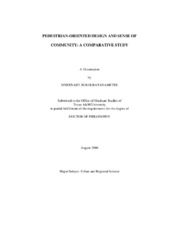| dc.contributor.advisor | Huang, Chang-Shan | |
| dc.creator | Sukolratanametee, Sineenart | |
| dc.date.accessioned | 2010-01-15T00:13:55Z | |
| dc.date.accessioned | 2010-01-16T02:17:54Z | |
| dc.date.available | 2010-01-15T00:13:55Z | |
| dc.date.available | 2010-01-16T02:17:54Z | |
| dc.date.created | 2006-08 | |
| dc.date.issued | 2009-06-02 | |
| dc.identifier.uri | https://hdl.handle.net/1969.1/ETD-TAMU-1871 | |
| dc.description.abstract | The primary objective of the research is to examine the attempt of new urbanism
principles to promote a sense of community through its pedestrian-oriented design
guidelines of neighborhoods. The following questions will be addressed to examine the
subject. First, do residents of a new urbanism neighborhood have a higher level of sense
of community than residents of a typical suburban neighborhood? Second, is there an
evidential support that pedestrian-oriented design features of new urbanism enhance the
sense of community in a neighborhood? Finally, do residents of a pedestrian-oriented
design neighborhood have more out-of-door activities in their neighborhood than
residents of a typical suburban neighborhood?
To examine the relationship between neighborhood design and sense of
community, a comparative study was conducted in four subdivision neighborhoods
located in the Houston metropolis, Texas. The first two neighborhoods exhibit
pedestrian-oriented design principles and features of new urbanism, although each to
different degrees. The other two neighborhoods are typical suburban neighborhoods that are not specifically designed to accommodate pedestrians and usually have less public
spaces. The methods of collecting data are self-administered questionnaires, systematic
observations, and unstructured interviews of residents in the four neighborhoods.
The research findings provide evidence that the residents in pedestrian-oriented
neighborhoods have a higher level of supportive acts of neighboring (SAON) and
neighborhood attachment & weak social ties (NA&WST) than those of typical suburban
neighborhoods. The findings also provide partial support for the relationships between
the design factor (pedestrian-oriented design) and two dimensions of sense of
community investigated-SAON and NA&WST. Additionally, the findings strongly
indicate that the social processes, measured through selected demographic and nonenvironmental
design variables, have their own unique and vital role on the sense of
community in the neighborhoods, and that physical design has no impact on the way the
social processes work on the sense of community in the neighborhood. The roles of
physical design and social process are independent from each other. Finally, the results
partially support the hypothesis that residents of pedestrian-oriented design
neighborhoods have a higher level of out-of-door activities than residents of typical
suburban neighborhoods. | en |
| dc.format.medium | electronic | en |
| dc.format.mimetype | application/pdf | |
| dc.language.iso | en_US | |
| dc.subject | new urbanism | en |
| dc.subject | sense of community | en |
| dc.title | Pedestrian-oriented design and sense of community: a comparative study | en |
| dc.type | Book | en |
| dc.type | Thesis | en |
| thesis.degree.department | Landscape Architecture and Urban Planning | en |
| thesis.degree.discipline | Urban and Regional Science | en |
| thesis.degree.grantor | Texas A&M University | en |
| thesis.degree.name | Doctor of Philosophy | en |
| thesis.degree.level | Doctoral | en |
| dc.contributor.committeeMember | Abrams,Robin | |
| dc.contributor.committeeMember | Neuman, Michael | |
| dc.contributor.committeeMember | Rogers, George | |
| dc.type.genre | Electronic Dissertation | en |
| dc.type.material | text | en |
| dc.format.digitalOrigin | born digital | en |


